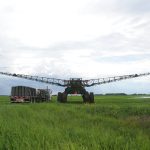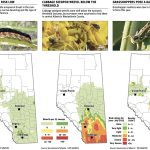Tag Archives insects

Producers urged to protect beneficial insects
Research scientist says farmers should not throw the baby out with the bathwater when it comes to battling crop pests

Manitoba’s biggest crop pests of 2024
Flea beetles, cutworms, armyworms, lygus bugs and more all ate away at farm profits last year in Manitoba

Producers urged to keep eyes peeled for insects
Populations were mostly small for key pests in Alta. last year, but there were plenty of hot spots so scouting remains vital
Alberta has released its 2024 survey maps for three of canola’s hungriest insect pests: Bertha armyworm, cabbage seedpod weevil and grasshoppers. All three pest populations were relatively small, although hot spots appeared throughout the province. In all three cases, releases from Alberta Agriculture and Irrigation emphasized scouting and when to do so for best results. […] Read more
Singapore approves edible insects amid food security push
The city state’s authority approved 16 insect species for human consumption including grubs and grasshoppers
SINGAPORE (Reuters) — At Singapore’s House of Seafood restaurant, the fish-head curry comes with a side of crunchy crickets, the tofu has bugs crawling out of it and the patrons can’t get enough. The seaside restaurant is the first eatery to put insects on the menu after the city state’s stringent food authority approved for […] Read more
Nutrien purchases bio-control

Native insect acquires new taste for soybeans
The soybean tentiform leafminer has been seen in Manitoba creating leaf injuries on the lower and upper surface
A tiny North American moth species that has been seen in Canada has been developing a new appetite for soybean plants on the U.S. Plains. The species, Macrosaccus morrisella — now officially named the soybean tentiform leafminer — was detected feeding on soybean crops in eastern Minnesota in 2021 and has since taken its newfound […] Read more
The wild side of pollination

Warm December delighted grain beetles; farmers not so much

Bugs: always eager to eat and ready to hide
You don’t even know they were in your crop until after they’ve had their free lunch and moved on over to your neighbour’s
Insects are always eager to decimate pulse crops. There’s a wide array of the destructive little bugs, and they go about doing their damage in a number of different ways. Their timing, devious behavior and variety of modes of action make outbreaks difficult to predict with a high degree of accuracy, according to entomologists. “And […] Read more



